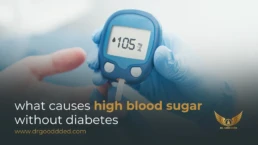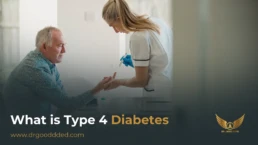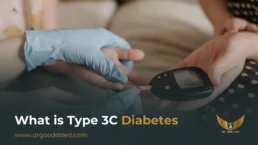Type 1 diabetes happens when your immune system destroys insulin-making beta cells in the pancreas. Type 2 diabetes starts when your body resists insulin, then the pancreas cannot keep up. That is the direct answer.
Table of Contents
ToggleThe difference between type 1 diabetes and type 2 diabetes is the driver of high blood sugar. In one, insulin supply drops. In the other, cells stop listening to insulin. Knowing this helps you act early, pick the right tests, and follow the best plan.
What Is The Main Difference Between Type 1 And Type 2 Diabetes
Key Distinction: Autoimmune Vs. Insulin Resistance
In type 1 diabetes, antibodies attack beta cells. Insulin falls to very low levels. You need replacement to live and to prevent acid buildup. In type 2 diabetes, your muscles, liver, and fat cells resist insulin. The pancreas tries to push out more. Over the years, output fades. That is how type 1 differs from type 2 diabetes at the root.
How the Pancreas Functions Differently In Both Types
- Type 1 diabetes: little to no insulin is made after the attack. Glucose rises fast. Ketones rise.
- Type 2 diabetes: insulin is present at first. It is often high. Cells ignore it. Later, beta cells tire and insulin drops.
Typical Age Of Onset And Progression Rate
Type 1 diabetes can start at any age. It often starts in kids or teens. The rise is quick, over days or weeks. Type 2 diabetes is more common after age 35. It now shows up in teens with high weight and family risk. The rise has been slow over the years.
Can Type 1 Develop Later In Life, Or Type 2 In Children
Yes. Adults can get slow-moving autoimmune diabetes called LADA. It is a form of type 1 diabetes. Children can develop type 2 diabetes when insulin resistance is strong. So age alone never proves the type. Testing does.
What Type 1 Diabetes Vs Type 2 Diabetes Causes
Autoimmune Reaction In Type 1 Diabetes
Your immune system mistakes beta cells as a threat. Antibodies such as GAD65, IA-2, ZnT8, or insulin autoantibodies may show up on tests. Genes raise risk. A few viruses may trigger the attack in those at risk. These are the causes of type 1 diabetes you can measure or track with your team.
Insulin Resistance In Type 2 Diabetes
In type 2 diabetes, fat cells release signals that block insulin’s message. Muscle cells do not pull in glucose well. The liver makes extra glucose even when sugar is already high. Extra belly fat, low daily movement, and genes drive this process. These are the main causes of type 2 diabetes today.
Role Of Genetics, Lifestyle, And Obesity
- Genes: both types run in families.
- Weight: central fat has strong links to type 2 diabetes.
- Activity: low muscle use worsens insulin resistance.
- Food pattern: lots of sugary drinks and refined carbs raises risk.
- Immune triggers: more relevant to type 1 diabetes than weight is.
Hormonal And Metabolic Triggers
Cortisol and adrenaline rise with stress. They raise blood sugar. Poor sleep alters hunger hormones. Appetite grows. You snack more. For type 2 diabetes, that adds to resistance. For type 1 diabetes, stress can reveal low insulin reserve and push you toward ketones.
Type 1 Vs Type 2 Diabetes Symptoms
Early Warning Signs Common To Both Types
- Thirst that does not let up
- Frequent urination, even at night
- Blurry vision that comes and goes
- Fatigue and brain fog
- Slow-healing cuts or frequent skin issues
These overlap, which is why labs are key.
Type 1 Symptoms: Sudden Onset And Severe Thirst, Fatigue, Weight Loss
Type 1 diabetes often shows a fast pattern. You may lose weight without trying. You may feel sick, with belly pain and nausea. Your breath can smell fruity due to ketones. These are classic type 1 symptoms. This pattern needs quick care.
Type 2 Symptoms: Slow Progression, Blurred Vision, Frequent Infections
Type 2 diabetes often creeps up. You may notice tingling in your feet. Gum, skin, or vaginal infections come back more often. Fatigue grows. Many feel fine for years. These are common type 2 diabetes symptoms that should prompt a screen.
When To Get Tested For Diabetes Symptoms
Test now if you notice any signs above. Test earlier if you have risk factors:
- A parent or sibling with type 2 diabetes
- Waist gain or a body mass index in the high range
- High blood pressure or abnormal lipids
- Diabetes in pregnancy in the past
- PCOS in women or sleep apnea in anyone
Diagnosis And Testing For Both Types
Fasting Glucose, HbA1c, And Oral Glucose Tolerance Tests
Doctors confirm both type 1 diabetes and type 2 diabetes with standard cutoffs:
- A1C 6.5% or higher
- Fasting plasma glucose 126 mg per dL or higher
- Two-hour value 200 mg per dL or higher on the oral glucose drink test
- Random plasma glucose 200 mg per dL or higher with symptoms
A1C shows three months of average sugar. Fasting glucose shows your baseline. The drink test shows how your body handles a sugar load.
Antibody Tests For Identifying Type 1 Diabetes
If the story is unclear, your doctor can order antibodies. A positive test supports type 1 diabetes. A clear negative may point to type 2 diabetes when the clinical story fits. This narrows the difference between type 1 diabetes and type 2 diabetes when age or weight mislead.
C-Peptide And Insulin Levels To Differentiate Types
C-peptide is a marker that tracks your own insulin output. Low C-peptide during high sugar suggests type 1 diabetes. Normal or high C-peptide suggests type 2 diabetes. Results guide type 1 treatment or type 2 diabetes treatment choices.
Type 1 Vs Type 2 Diabetes Treatment Options
Insulin Therapy: Essential For Type 1, Sometimes Needed For Type 2
You need insulin to live with type 1 diabetes. Most plans use:
- Basal insulin for round-the-clock needs
- Bolus insulin for meals and snacks
- Correction doses for unplanned highs
In type 2 diabetes, insulin may be short-term at diagnosis if sugars are very high. It may also be long-term when beta cells tire. The dose depends on carbs, activity, illness, and stress. This is how type 1 differs from type 2 diabetes in day-to-day life.
Oral Medications For Managing Type 2 Diabetes
The first line is often metformin. It lowers liver glucose output and helps insulin work better. If heart or kidney risk is high, many add an SGLT2 inhibitor. If weight is a big issue, your doctor may consider a GLP-1 receptor agonist. Many people use both over time. These choices form the core of type 2 diabetes treatment today.
Role Of Continuous Glucose Monitoring
CGM shows your numbers every few minutes. It shows arrows for trends. You get alerts for lows and highs. CGM helps you time meals, adjust doses, and plan workouts. It helps most people with type 1 diabetes. It also helps many with type 2 diabetes who use insulin or who need tight feedback.
Lifestyle Interventions: Diet, Exercise, And Weight Management
Food pattern:
- Choose high fiber carbs like beans, oats, and whole grains.
- Add lean protein such as eggs, fish, tofu, chicken, or dal.
- Use healthy fats from nuts, seeds, and olive oil.
- Spread carbs across the day.
- Reduce sugary drinks and refined snacks.
Movement:
- Aim for at least 150 minutes per week of brisk walking or cycling.
- Add two short strength sessions weekly.
- Break up long sitting every 30 minutes.
Even a 5 to 10 percent weight drop improves insulin action in type 2 diabetes. Sleep 7 to 9 hours. Keep a steady bedtime. Plan stress breaks. These steps support any type 1 treatment plan, too, since stable habits make insulin dosing smoother.
How Type 1 Differs From Type 2 Diabetes In Long-Term Management
Monitoring Frequency And Technology Use
With type 1 diabetes, you check more often. Many use CGM, smart pens, or pumps. With type 2 diabetes, checks can be less frequent when not on insulin. CGM can still guide you during a new plan, illness, or dose changes.
Risk Of Complications And Long-Term Outcomes
Both types can lead to eye disease, nerve damage, foot ulcers, heart attack, stroke, and kidney failure if sugar stays high. The risk pattern is not the same. Type 2 diabetes often brings a higher load of blood pressure and lipid issues. That raises heart and kidney risk early.
Tight sugar control, blood pressure control, and statins lower that risk. For type 1 diabetes, early insulin education and low-glucose awareness training help prevent severe lows and long highs.
Emotional And Psychological Impact Of Living With Each Type
Numbers, alarms, and meal math can feel draining. With type 1 diabetes, fear of lows is common. With type 2 diabetes, shame or blame can delay care. Both need real support. Ask for a referral to a diabetes educator. Ask for mental health help if worry or burnout grows. A steady plan beats a perfect plan you cannot keep.
At-A-Glance Comparison Table
| Feature | Type 1 diabetes | Type 2 diabetes |
| Main driver | Autoimmune beta-cell loss | Insulin resistance then beta-cell fatigue |
| Onset | Often sudden | Usually slow |
| Insulin at diagnosis | Needed | Sometimes |
| Body weight at onset | Any | Often higher but not always |
| Ketones and DKA risk | High if untreated | Lower, yet possible in stress or with SGLT2 use |
| Key tests to sort types | Antibodies, low C-peptide | Absent antibodies, normal or high C-peptide |
| Core therapy | Insulin for life | Lifestyle plus oral or injectable agents, insulin when needed |
Complications: Are They The Same Or Different
Both type 1 diabetes and type 2 diabetes can cause long-term damage when sugar stays high. The damage builds slowly and affects blood vessels. The key difference is which problems tend to appear first.
Cardiovascular And Kidney Complications In Type 2 Diabetes
People with type 2 diabetes often have high blood pressure and high cholesterol at the same time. These raise the chance of:
- Heart attack
- Stroke
- Kidney disease
The kidneys filter waste from the blood. High sugar and high pressure strain these filters. Over time, they harden and scar. This is why checking urine protein and kidney labs is part of type 2 diabetes treatment. Early control lowers the risk of dialysis later.
Diabetic Ketoacidosis In Type 1 Diabetes
In type 1 diabetes, there may be little to no insulin. Without insulin, the body uses fat for fuel. This makes ketones. When ketones build up too fast, the blood becomes acidic. This is diabetic ketoacidosis (DKA). It is an emergency. It happens most in type 1 diabetes, but it can happen during illness in type 2 diabetes as well. Fast help is needed if someone has:
- Deep thirst
- Fast breathing
- Belly pain
- Vomiting
- Confusion
Overlap Conditions Like Neuropathy And Retinopathy
Both conditions can lead to nerve damage (neuropathy). Feet may feel numb or burn. Cuts can go unnoticed. Eye disease (retinopathy) can lead to vision loss if not treated. Sugar control, regular exams, and foot care are important whether you have type 1 diabetes or type 2 diabetes.
Can Type 1 Diabetes Turn Into Type 2
Why “Double Diabetes” Can Occur In Rare Cases?
Type 1 Diabetes cannot turn into Type 2. The disease does not switch. But a person with type 1 diabetes can also become insulin resistant. When this happens, the person now has both an immune loss of insulin and insulin resistance. This is called double diabetes.
The Role Of Weight And Insulin Resistance In Type 1 Patients
When someone with type 1 diabetes gains excess weight, the body’s cells may start ignoring insulin. The insulin dose must increase. Blood sugar rises faster after meals. The same pattern seen in type 2 diabetes appears. This is why food choices, movement, and sleep matter in type 1 diabetes, too.
Preventing Metabolic Overlap Through Early Control
Healthy weight range, regular exercise, and steady meal timing lower the chance of double diabetes. Working with a diabetes educator or nutrition expert early helps control the overlap before it becomes harder to manage.
Prevention And Early Management Of Type 2 Diabetes
Screening For Prediabetes And Metabolic Risk Factors
Prediabetes means blood sugar is higher than normal but not high enough for type 2 diabetes. Screening is important if you:
- Have a family member with type 2 diabetes
- Carry extra weight around the waist
- Have had diabetes during pregnancy
- Have PCOS or sleep apnea
Early screening allows change to begin before medications are needed.
How Diet And Exercise Delay Or Prevent Type 2 Onset
A stable eating pattern matters. Meals should include protein, fiber, and healthy fat. These help slow glucose rise. Even a small weight drop improves insulin response. Regular walking improves muscle sugar use. These steps work because they target the causes of type 2 diabetes at the source.
Can Autoimmune Risk Be Reduced In High-Risk Families
The causes of type 1 diabetes involve immune triggers. There is no proven way to prevent this type in the general public. But family members can get antibody testing to check risk. Researchers continue to study whether early immune therapy could delay the onset.
Living With Diabetes: Daily Care And Monitoring
Glucose Tracking And Target Ranges
Checking sugar is a daily part of care. CGM alarms help prevent highs and lows. Targets differ by age and medical needs. Your doctor can set your range and A1C goal. Monitoring helps both type 1 treatment and type 2 diabetes treatment work better.
Managing Stress And Sleep For Better Control
Stress releases hormones that raise sugar. Lack of sleep changes hunger patterns. A routine sleep schedule and simple relaxation habits help reduce swings in both type 1 diabetes and type 2 diabetes.
Importance Of Medical Follow-Ups And HbA1c Checks
Regular visits allow dose changes and new goal setting. Eye exams, kidney labs, and foot checks prevent major problems before they start. Consistent follow-ups matter.
FAQs
Can You Have Both Type 1 And Type 2 Diabetes
Yes, a person can have type 1 diabetes and also develop insulin resistance similar to type 2 diabetes. This is often called double diabetes and requires careful monitoring and balanced meal planning.
Is Type 2 Diabetes Reversible With Weight Loss
Some people with type 2 diabetes can reach normal sugar levels with weight loss and better eating patterns. This is called remission and requires long-term commitment to be maintained.
How Is Juvenile Diabetes Different From Adult-Onset Diabetes
Juvenile diabetes usually refers to type 1 diabetes in children, while adult-onset diabetes commonly refers to type 2 diabetes in adults. However, age cannot confirm the type because both can appear at any age.
Do Both Types Of Diabetes Need Insulin Injections?
Type 1 diabetes always needs insulin because the pancreas makes little or none. Type 2 diabetes may or may not need insulin, depending on how much the pancreas can still produce.
How Can I Tell If My Symptoms Are Type 1 Or Type 2?
Rapid weight loss, vomiting, and fruity breath suggest type 1 diabetes. Slow changes, frequent infections, and fatigue suggest type 2 diabetes. Testing is required for a clear diagnosis.
Can Type 2 Diabetes Develop Into Type 1 Later In Life?
No. The diseases have different causes. Type 2 diabetes does not turn into type 1 diabetes. However, a person with advanced type 2 diabetes may make less insulin and require insulin therapy.
What Diet Works Best For Each Diabetes Type?
Both types benefit from whole foods, fiber, protein, and fewer sugary drinks. Carb counting is helpful in type 1 diabetes. Weight management has a large effect on type 2 diabetes.
How Does Stress Impact Blood Sugar In Type 1 Vs Type 2?
Stress hormones raise blood sugar in both groups. In type 1 diabetes, insulin doses may need to be changed. In type 2 diabetes, stress worsens insulin resistance.
Which Type Of Diabetes Is More Genetic?
Both types have genetic links. Family history has a stronger pattern in type 2 diabetes, while type 1 diabetes involves genes and immune triggers.
What Happens If Both Types Are Left Untreated?
Sugar rises and damages blood vessels. This can lead to blindness, kidney failure, nerve damage, and heart disease. In type 1 diabetes, DKA can develop, which is life-threatening.
Can Exercise Reduce Insulin Needs In Type 1 Diabetes?
Yes. Muscles use glucose during activity without needing as much insulin. Regular exercise often lowers insulin needs in type 1 diabetes safely.
Is Type 2 Diabetes Always Caused By Obesity?
No. Many factors lead to type 2 diabetes. Weight is only one factor. Genes and insulin response also play roles.
What Are The Early Signs Of Insulin Resistance?
Common early signs include belly weight gain, feeling tired after meals, skin darkening on the neck folds, and rising triglycerides.

This article is medically reviewed by Dr. Nivedita Pandey, Senior Gastroenterologist and Hepatologist, ensuring accurate and reliable health information.
Dr. Nivedita Pandey is a U.S.-trained gastroenterologist specializing in pre and post-liver transplant care, as well as managing chronic gastrointestinal disorders. Known for her compassionate and patient-centered approach, Dr. Pandey is dedicated to delivering the highest quality of care to each patient.










